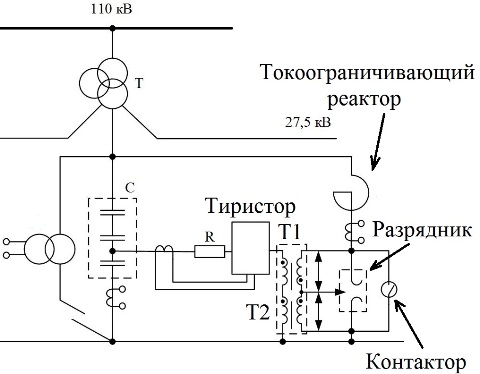Longitudinal reactive power compensation — physical meaning and technical implementation
To improve the efficiency of existing power lines, as well as to improve their throughput, devices for longitudinal compensation of reactive power are used. Today, the abundance of different generating sources with different capacities, as well as high-voltage lines, especially those that transmit electricity over long distances, leads to a growing demand to increase not only the reliability of power systems in general, but also to improve their efficiency .
There are two ways to increase the transmission capacity of power lines, the first of which is to directly increase the cross-section of the line, and the second is to use longitudinal schemes to compensate for reactive power. The second way—longitudinal reactive power compensation—proves to be a more economical way to achieve this goal for both inter-system and intra-system connections.
It is known that when reactive power is transmitted over wires, there are significant voltage drops and current increases in sections of electrical networks, and this creates limitations on the transmission of useful, active power.
Longitudinal reactive power compensation implies additional connection of capacitors in series with the load by means of step-up or isolation transformers, which makes it possible to achieve automatic voltage regulation depending on the current value of the load current.
Of course, with longitudinal compensation, emergency modes are inevitable, the reasons for which can be:
-
shunting of capacitors, which can cause surges;
-
damage to the capacitors from the inside.
To avoid damage from a sudden increase in voltage, the capacitors at such times must be automatically disconnected by a high-voltage switch or immediately discharged through a spark gap.
Since the reactive power compensation capacitors are connected in series in the AC circuit, the entire line current flows through them and therefore the short circuit current, if any, will also flow through them.
To increase the transmission capacity, longitudinal compensation is applied in high-voltage lines, which ensures the stability of power systems that include these lines.
In longitudinal compensation, the capacitor current is equal to the total load current I flowing through it, and the capacitor bank power Q is a variable value that depends on the load at any given time.This reactive power can be calculated using the formula:
Bk =Az2/ωC
And since the power of the capacitors in the process of longitudinal compensation does not remain constant, then the voltage also increases by an amount that is proportional to the change in the reactive load of the given line, that is, the voltage of the capacitors is by no means constant, as in the cross compensation of the reactive power.
Switching capacitive longitudinal compensation units are very popular today. Such installations are used to reduce the influence of the inductive component of the reactance of transformers of traction networks and traction substations on the voltage applied to the pantograph of an electric locomotive. Here, as mentioned above, a capacitor is connected in series with the pantograph.
At Russian traction substations, these installations are installed in a suction line, where the installation of longitudinal compensation serves to increase the voltage, prevent the effect of leading or lagging phases, symmetrical voltages with equal currents are obtained in the supply arms, the general voltage class for working equipment is reduced and the design of the installation is simplified...

The figure shows a diagram that shows only one section of longitudinal compensating capacitors, of which there are actually several connected in parallel with each other.
The voltage to the low-voltage windings of transformers T1 and T2, connected in series, is supplied by a row of capacitors through a thyristor switch and a limiting resistor.In this case, the high-voltage windings of these transformers are connected in opposite directions, and with a short circuit, the voltage in the capacitors increases.
The moment the voltage reaches the setting, the thyristor switch is triggered and the arc of the three-electrode discharger is immediately ignited. When the vacuum contactor is turned on, the arc in the discharger is extinguished.
The advantages of such installations for longitudinal compensation include:
-
symmetrical bus voltage;
-
reducing voltage fluctuations and increasing its level at electrical receivers.
Cons:
-
difficult operating conditions of the installation's capacitors compared to lateral compensation, since the short-circuit current of the traction network flows through the capacitors, and reliable over-speed protection is required here;
-
overloading of capacitors in dangerous modes: forced, emergency, post-emergency.
To achieve the best effect of reactive power compensation, adjustable installations with combined operation of longitudinal and lateral compensation should be used.

The advantages of using longitudinal compensation installations in general include:
-
increasing the power transmitted on the line;
-
improving the stability of power systems during peak loads;
-
significant reduction of active power losses;
-
improving the quality of electricity in networks;
-
high efficiency of power distribution in parallel lines;
-
the need to build generating sources in remote areas is eliminated;
-
interconnection sections and technical parameters of the lines do not need to be increased.
The main economic advantage of using longitudinal compensating devices is energy saving. Not only that electricity quality improves, so the number of power lines can be reduced if longitudinal reactive power compensation is used. Environmental protection is a natural consequence of the introduction of this technology, especially on a large scale.
The cost of installations is such that a new transmission line costs 10 times more than a longitudinal compensation device with the same transmission capacity. As a result, the recovery of such a system is only a few years compared to traditional transmission lines.
